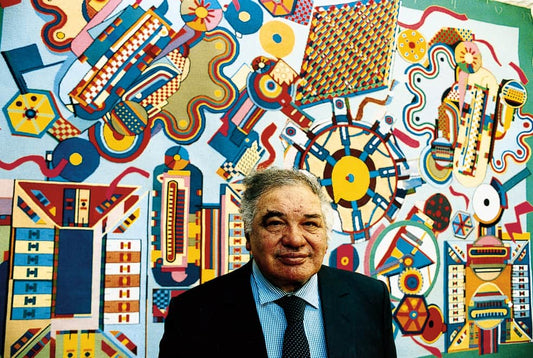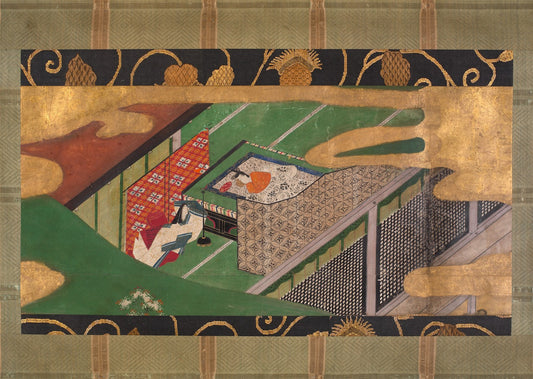Feature image: Artist Sougwen Chung works in her Brooklyn studio. Image by Celeste Sloman for The Washington Post via The Washington Post
Robotics in Art
The intersection of art and science is constantly being explored by artists in experimental and unexpected ways. Involving robots in art is just one way the gap between science and art is bridged, and although it may seem like a modern phenomenon, there is much more to learn regarding this novel blend of technology and creativity.
Explore the depths of the history of robotics in art, consider the ethical questions with which artists grapple, and marvel at the notable works created with mechanical assistance.

History and Definition
With AI art being such a hotly debated and frequently misunderstood topic, it’s important to distinguish between robots in art and AI art. Some artists may employ text-prompt-based AI programs commonly found online, like OpenArt or Craiyon for inspiration. Still, AI programs like these are limited in their art capabilities, as the art they create is based on the text the user inputs as well as the data on which the AI was trained. Robots, though, have physical “bodies”—those that utilize AI technology do so for a myriad of functions, including movement and visual recognition.

The first examples of robotics and automata within practical objects are earlier than some might think. Early Chinese hydraulic-powered machines and toys, which could be considered robots, date back as far as the Han dynasty (year). The Prague Astronomical Clock in Czechia is another impressive feat of robotics. First constructed in 1410, the clock features four animatronics representing vanity, greed, death, and lust that move on the hour.

Robots in art, however, didn’t begin to appear until the mid-20th century. Like the Prague Astronomical Clock nearly five centuries earlier, Nam June Paik and Shuya Abe’s 1964 creation Robot K-456 completely innovated how robots were used for entertainment and artistic purposes. A 20-channel remote-controlled robot, it was able to walk around, play a recording of John F. Kennedy’s 1961 inaugural speech, and “excrete” small dried white beans. Using a robot as a form of performance art would carry on into the 21st century when public excitement about robots began to accelerate.
Roboethics and Public Perception
Roboethics is the field that concerns the ethical considerations of creating and interacting with robots. It includes the question of whether or not humans have a moral obligation to afford robots rights. Even more specific ethical and philosophical questions may arise for artists and viewers when using robots for art.
Rapid and drastic changes in technology will always make some wary, and the depiction of robots in science fiction media has largely soured the public’s perception of robots. These fears and concerns humans have towards robots remain when the robot is used for an artistic purpose. When confronted with robotic art, some may ask themselves, “What will happen to art if robots come to ‘replace’ human artists?” or “Can a robot really create art?”.
In a 2015 NPR article titled “ You Can Give a Robot A Paintbrush, But Does It Create Art ?” Mark Riedl, an associate professor at the Georgia Tech School of Interactive Computing, argued that robots can engage in creativity to some extent—but not in the abstract way you think. “Anything that produces anything or solves a problem is undergoing a creative process. Solving a math problem is a creative process,” Riedl explained. To be on the creative level of humans, though, a robot would have to be able to produce something that’s taken on an “additional level of meaning”. Whether or not robots will eventually be capable of this abstract creativity remains to be seen.
In the present, artists have worked together with robots to create stunning works of art and have the robot be the art in captivating showcases of performance. These three recent examples of robotics in art demonstrate the incredible feats art and science can achieve in combination.
Notable Works and Artists
Can’t Help Myself (2016-2019) - Sun Yuan and Peng Yu
This viral work by Chinese conceptual art duo Sun Yuan and Peng Yu first debuted in 2016 at the Guggenheim Museum in New York. Can’t Help Myself featured a KUKA industrial robot with a customized arm programmed to perpetually clean the red liquid that oozes from its base—never quite accomplishing its task completely. The robot was also outfitted with visual recognition sensors that allowed it to “dance” for viewing audiences. Sun and Peng worked with two robotic engineers to create 32 movements for the robot to perform.

Sun and Peng, artists known for their use of unconventional materials, had an “initial wish to test what could possibly replace an artist’s will in making a work and how they could do so with a machine,” according to the Guggenheim. In this instance, the Can’t Help Myself robot takes on the role of a performer rather than that of a collaborator or fellow artist. The robot and its actions are the art, contributing to this piece’s immense staying power.
Sougwen Chung
Chinese-Canadian artist Sougwen Chung has been investigating “the interactions between mark-made-by-hand and the mark-made-by-machine as an approach to understanding the dynamics of humans and systems” in her art for nearly a decade. But she’s not alone in this—she works with her robot collaborator, Doug. An acronym for “Drawing Operations Unit, Generation X,” Doug is powered by AI, allowing it to “respond spontaneously to Chung’s lines and brushstrokes, creating a feedback loop with her of improvised, communal creation,” according to the Washington Post. A small, round unit that rolls across the floor, similar to a Roomba, Doug is outfitted with a short chalk brush on its front to help Chung create fluid, dynamic art pieces that feel like something straight out of the future. Before the COVID pandemic, Chung and Doug would create their pieces in front of a live audience. In these contexts, Doug was both a collaborator and a performer. This makes Chung’s robotic art unique, as the experience of watching the art being made is also art in itself.

“Doing this work has taught me a few things. It's taught me how embracing imperfection can actually teach us something about ourselves. It's taught me that exploring art can actually help shape the technology that shapes us. And it’s taught me that combining AI and robotics with traditional forms of creativity—visual arts in my case—can help us think a little bit more deeply about what is human and what is the machine. And it's led me to the realization that collaboration is the key to creating the space for both as we move forward.”
Chung’s hopeful, optimistic view on the combination of art and science brings a refreshing perspective to the debate, inspiring artists and viewers to have a more open mind regarding man and machine.
Agnieszka Pilat
What do you get when you teach a dog to paint? A lot of messy paw prints, probably. What about a robot dog? A place in the hearts and minds of tech billionaires in Silicon Valley. Agnieszka Pilat emigrated to the U.S. from Poland to escape communist rule and eventually went on to study traditional European figure painting. But her fascination with “the miracle” of technology was ever-present, having grown up with very little during the Cold War.

So when the opportunity arose for her to take on two tech-savvy painting apprentices, she leaped at the chance. Her new students were the tech. The apprentices—Basia and Bunny—are two bright yellow, four-legged robotic “dogs” created by Boston Dynamics, who brand the robot as “ Spot.” Spot robots were originally designed for use in work situations that were too dangerous for humans, with their AI capabilities allowing them to scan their environment for hazards and additional essential information. They’ve also notoriously seen use within the law enforcement field.
Basia and Bunny, though, are Pilat’s muses. Before creating art with the help of the Spot robots, Pilat painted their portraits first. Then, it was their turn to create something. Both Basia and Bunny “paint” using an arm attachment that allows them to hold a paintbrush, creating strokes by following commands input by the user. Together, Pilat and Basia have created several striking, abstract pieces, including Machine Forest, Emperor, and Mary and Child. All of Pilat, Basia, and Bunny’s collaborative paintings are composed of nothing more than a collection of straight lines and small circles, but knowing they were created almost entirely by a machine evokes a profound feeling in the viewer.
Pilat feels strongly about her robot dogs, realizing that people need to be properly introduced to this kind of technology to become open to its vast potential, particularly in the creative sphere. She wants robotic technology to be nurtured by humanity so man and machine can work together, a line of thinking similar to Sougwen Chung’s beliefs.
“Machines are children of humanity. So us, as good parents, stewards of machine technology and AI, it’s our obligation to culturally and morally have a relationship with them so they grow up to be good citizens.”
As the debate surrounding the inclusion of technology, artificial intelligence, and science within art continues to grow, artists working with robots seek to be at the forefront of a new relationship between the creative and the technological: one of collaboration.
This may seem impossible, given the perceived gap between art and science. Both disciplines have sought to push possibilities in their respective fields. If both art and science have that in common, then collaboration for art’s sake will become even more desired in the coming years.
©ArtRKL™️ LLC 2021-2024. All rights reserved. This material may not be published, broadcast, rewritten or redistributed. ArtRKL™️ and its underscore design indicate trademarks of ArtRKL™️ LLC and its subsidiaries.





